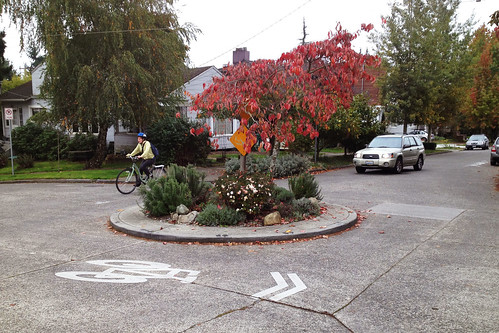I'm in Seattle this week for the Rail~Volution conference. Here's a look at things I'm seeing and doing.
Seattle residents were sick of speeding cut-through traffic on neighborhood streets. In response, the city is creating a network of "neighborhood greenways" designed to slow drivers and make it safer to get around by foot or bike.
 |
| A cyclist and a driver navigate a roundabout on a "neighborhood greenway" in Seattle's Wallingford neighborhood. All photos by the author. |
Neighborhood greenways are sort of a carrot and stick approach: speed bumps, physical diverters and small roundabouts at each intersection slow drivers down, discouraging them from cutting through the neighborhood, or at least encouraging them to drive more carefully.
Meanwhile, improved sidewalks and marked crosswalks make it easier and safer to walk. Bike lanes and sharrows, or shared lanes, give cyclists a safer ride as well. And all of those roundabouts and bumpouts are great places for landscaping, putting the "green" in "neighborhood greenway."
Seattle first got the idea from Portland, which pioneered the neighborhood greenway a few years ago. The city has completed neighborhood greenways in two communities, including Wallingford, where I'm staying this week.
There are nine additional greenways elsewhere in the city in various stages of planning and construction. Residents are big fans of the project, and have even started a citywide advocacy group to identify potential greenways and push for them.
 |
| Ellsworth Drive in Silver Spring is closed to through traffic, but lacks amenities for walkers and cyclists. |
If the neighborhood greenway is a carrot and stick, traffic calming in the DC area is often just the stick. Hearing complaints from neighborhoods abutting commercial districts, local departments of transportation often respond by closing streets off entirely. This creates "fake cul-de-sacs" that not only push through traffic to main streets, but sometimes local trips as well.
But unlike neighborhood greenways, these treatments don't always come with pedestrian and bicycle improvements. In Bethesda, where Montgomery County's department of transportation limits access to several streets around downtown, parents say they can't safely walk their kids to school because of too-narrow sidewalks, poorly-timed stoplights, and a lack of crosswalks.
Speeding drivers and cut-through traffic can be a safety hazard, especially on narrow residential streets. But the answer isn't simply to keep them out, as some neighborhoods seek to do. By making it easier to get around without a car, neighborhood greenways create more transportation choices and make the street a more welcoming place for all.

1 comment:
MoCo loves cycling! Haven't you seen the bikeshare????? Focus on the bikeshare and not on the fact that getting from Burtonsville to DTSS is complicated and dangerous via bike.
Post a Comment